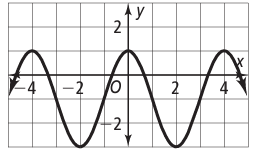FIND MAXIMUM MINIMUM VALUE AMPLITUDE FROM GRAPH OF PERIODIC FUNCTION
Maximum value :
The highest point reached by the curve in one pattern is known as maximum value of the periodic function.
Minimum value :
The lowest point reached by the curve in one pattern is known as minimum value.
Amplitude :
Amplitude is half the difference between the maximum value (peak) and the minimum value (trough) in a cycle.
y = (Max + Min)/2
Find the maximum, minimum, and period of each periodic function. Then copy the graph and sketch two more cycles.
Problem 1 :

Solution :
Maximum = 1, minimum = -3
The horizontal length of the pattern = 4 units.
So, period = 4
Graph of two more cycles :

Problem 2 :

Solution :
Maximum = 2, minimum = -1
The horizontal length of the pattern = 5 units.
So, period = 5
Graph of two more cycles :

Find the maximum, minimum and amplitude of each periodic function.
Problem 3 :

a. What is the period of the graph?
b. What is the amplitude of the graph?
Solution :
a) The horizontal length of one pattern = 10 seconds. So, the period = 10.
b) Amplitude = (Max - Min)/2
Maximum = -5, minimum = -9
= (-5 - (-9))/2
= (-5 + 9)/2
= 4/2
= 2
So, amplitude = 2
Find the maximum, minimum and amplitude of each periodic function.
Problem 4 :

Solution :
The graph doesn't have pattern. So, it is not a periodic function.
Problem 5 :

Solution :
It has a pattern, so it is a periodic function. The horizontal length of the pattern is 2 units. So, period is 2.
Maximum = 1, minimum = -1
Amplitude = (Max - Min)/2
= (1 - (-1))/2
= (1+1)/2
= 2/2
= 1
So, amplitude = 1
Problem 6 :

Solution :
It has a pattern, so it is a periodic function. The horizontal length of the pattern is 4 units. So, period is 4
Maximum = 2, minimum = -2
Amplitude = (Max - Min)/2
= (2 - (-2))/2
= (2+2)/2
= 2
= 1
So, amplitude = 1
Recent Articles
-
Finding Range of Values Inequality Problems
May 21, 24 08:51 PM
Finding Range of Values Inequality Problems -
Solving Two Step Inequality Word Problems
May 21, 24 08:51 AM
Solving Two Step Inequality Word Problems -
Exponential Function Context and Data Modeling
May 20, 24 10:45 PM
Exponential Function Context and Data Modeling